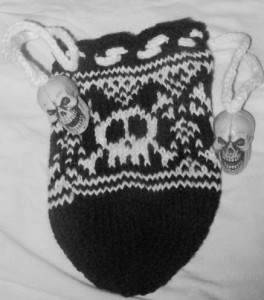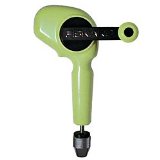After an accident with my flexible shaft drill, I realized I needed something that wouldn’t spin as fast for drilling small plastic items for beads. A friend of mine suggested the Fiskars Craft Drill.
Quick vocabulary list if you haven’t used drills before, the handle is the part you turn. The chuck is the part of the drill you put the bit in, it’s like a collar holding an X shape, you tighten the collar around the X to hold in the bit, or loosen the collar to release the bit. The bit is the part that drills.
The obvious limitations are that’s is a craft drill with a plastic body, it’s not meant to drill metal, or anything really serious, but for paper, plastic and that sort of thing, it’s wonderful. You have control over speed, since it’s manually powered, children can use it with supervision, and it’s quiet. Remember to always using something you don’t mind marking behind whatever you’re drilling. Old phone books work well for me.
The bits it comes with are a little big for the fine drilling I wanted to do, but after I got it home and out of the package, I couldn’t wait to try it. Changing the bit is easy. Hold the handle still while you twist the chuck open, slip in the bit, then turn the chuck to close. No chuck keys or anything like that, you do have to make sure it’s tightened as far as you can tighten it by hand.I drilled some Halloween skulls into big beads to put on a dice pouch I knitted my son.

The skulls are plastic and hollow, and the sort of thing my flexible shaft could have melted if I wasn’t paying attention.
I needed smaller bits, and I wasn’t sure if it would work with bits that were a lot finer. I got a small pack of 10 sizes including a 1/16th and 5/64th bit. They worked fine once I tightened the chuck up enough.
This works great with soft woods, chip board, and most plastics including resin. It’s quick and easy to use.
You can find the drill on Amazon.com by clicking the image below.


Pingback: Alexander6
Pingback: Alexander7